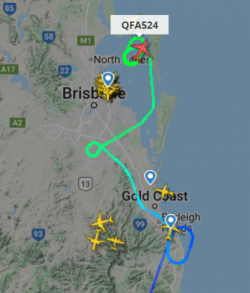jb747
Enthusiast
- Joined
- Mar 9, 2010
- Posts
- 13,502
30 knots is the maximum taxi speed in a straight line. Heavy aircraft going to the runway would rarely exceed 20 knots. But, for a turn you need the speed to be much lower. For the 380 less than 10 knots, and the 747 about 15 knots. Faster than that and the nosegear just skids, and you get a good lesson in understeer. So, anything you enter faster than that is ‘high speed’.Jb, does that mean that a 'high speed' turn-off is somewhat of a misnomer?
If I am interpreting what you've written correctly, you would generally exit at a high speed turn at 30 knots (not 50 knots unless you want to end up in the grass) and you transition to tiller at 'normal' taxi speed of 30 knots - therefore meaning that a 'high speed' turn-off is effectively at normal taxi speed?
The issue is that these taxiways often have an entry that you could do at pretty high speed, but they don’t have a similar exit. In fact, there’s a couple that I can think of in Oz, that have quite nasty turns in them…so an avenue to the grass. My theory was always that if you have an issue, then you should be able to exit the ‘high speed’ link and get back on to a straight at the same speed you entered. So, control your entry speed to ensure that’s the case.
To be quite honest, I always though it was a load of the proverbial, and I didn’t care whether the lights were on or off.It doesn’t look like QF has its cabin lights dimmed for takeoff?
Seems an equal mix of airlines that do, and don’t, have their cabin lights dimmed for takeoff and landing.
There are heroes everywhere. Perhaps he only got around to cancelling reverse when he got the slide back under control. Remember too, that I’m generally talking about wide bodies, not 737 guys who might land there 20 times a week. You can’t read anything into reverse. You could leave it engaged right down to a couple of knots, as long as the engine is at idle. Any deceleration you felt in the turn off was from brakes, not reverse thrust. It has virtually no reverse, and provides almost zero braking.Landed on QF BNE 01L and exited the runway very quickly yesterday and reverse wasnt cancelled until about 100 meters down the taxiway. Mind you the new runways and taxiways are very spacious on the new runway, but we were doing more than 30knots


















